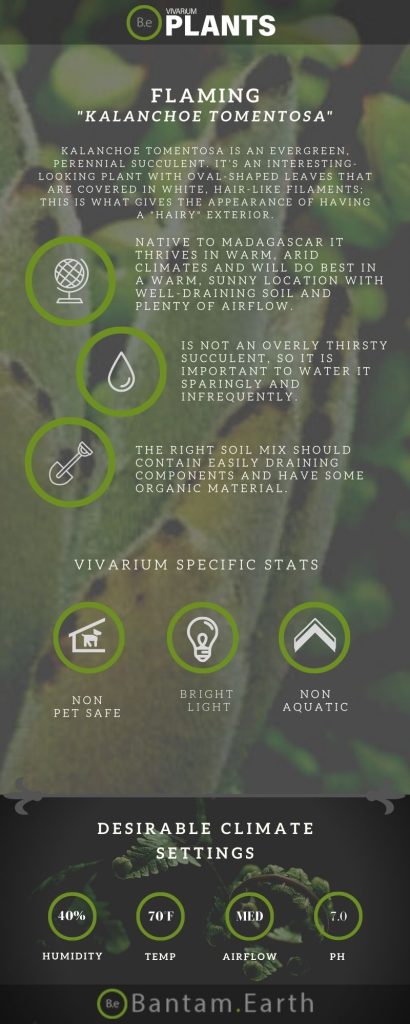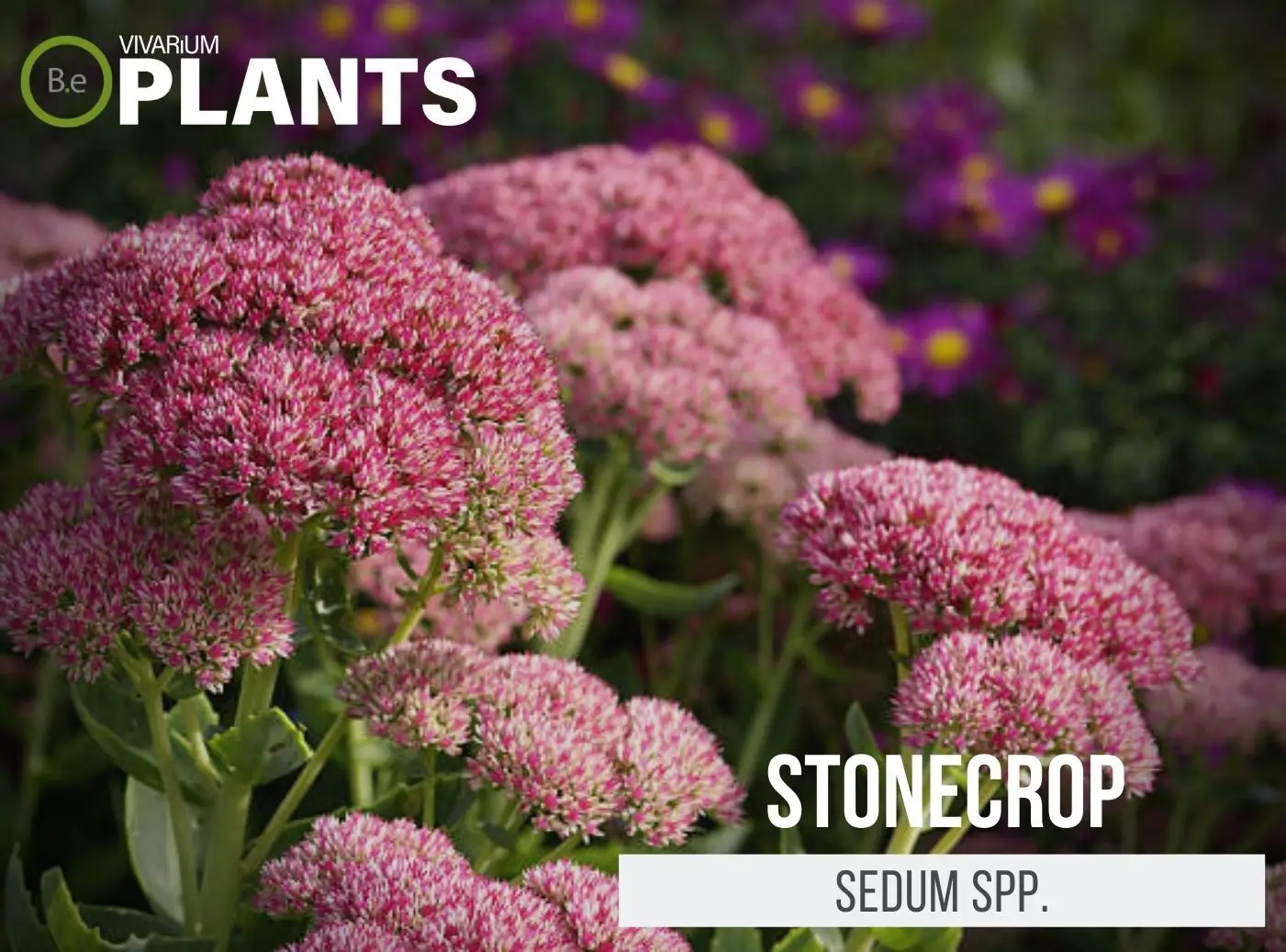Succulents have become increasingly popular houseplants in recent years, and the Panda Plant (Kalanchoe tomentosa) is a popular choice among enthusiasts looking to bring a bit of the outdoors in.
With its adorably fuzzy silver–grey leaves, the Panda Plant is sure to add character and life to any indoor terrarium.
In this article, we will explore the Panda Plant and how this resilient succulent is an ideal choice for DIY terrariums.
| Quick Stats: | |
|---|---|
| Scientific Name | Kalanchoe tomentosa |
| Common Name | Panda Plant, Cocoon Plant, Pussy Ears, Velvet Leaf |
| Family Name | Crassulaceae |
| Habitat | Arid climates |
| Temperature | 60°F to 85°F |
| Height | 4 to 5 inches |
| pH | 6.5 to 7.5 |
| Lighting | Bright, some sunlight |
What is Panda Plant?
Kalanchoe tomentosa is an evergreen, perennial succulent.
It’s an interesting-looking plant with oval-shaped leaves that are covered in white, hair-like filaments; this is what gives the appearance of having a “hairy” exterior.
The leaves are also a deep, dark green with a hint of red.
Panda plants can grow to 4-5 inches tall, with a maximum spread of 12 inches.


Panda Plant Facts
The panda plant is native to Madagascar, although it is widely cultivated for ornamental use in tropical, desert, and Mediterranean climates.
The unique fuzziness of Kalanchoe tomentosa is further accentuated by its jagged, thick foliage – a trait that many succulents share.
This Plant can be observed in multiple environments ranging from home vivaria to succulent gardens and even office cubicles!
Description
The panda plant is known for its soft, fuzzy leaves. Each leaf can increase in size up to 3 inches long, with the entire plant reaching a height of 4-5 inches.
The Panda Plant will produce flowers in shades of orange and yellow but these can take several years to develop, so in the meantime, the novelty will be in its unusual foliage.
The stems of the Velvet Leaf are sleek and glass-like but with a tendency to branch out laterally forming a bushy appearance.
Habitat
Kalanchoe tomentosa is native to Madagascar and derives its nickname “Panda Plant” from its resemblance to the iconic black and white animal.
It thrives in warm, arid climates and will do best in a warm, sunny location with well-draining soil and plenty of airflows.
The succulent can tolerate temperatures ranging from 60°F to 85°F.
pH Preference
Panda plant prefers a slightly acidic environment to grow best, with a pH range of 6.5 to 7.5.
Vivarium Type
The panda plant is quite an easy-going species. With that in mind, it will not be too complicated when it comes to choosing the type of enclosure it is grown in.
It is best to try and replicate the plant’s natural habitat as much as possible.
Doing so will make it easier to provide this succulent plant with its basic needs.
The proper setup and theme of the enclosure will make a big difference to the overall look and health of the plant. Here are recommended vivariums it will do well in:
-
- Terrariums – Fully terrain-based enclosures with little to no aquatic features.
Vivarium Placement
The panda plant is a low-maintenance, hardy succulent that can be placed in the foreground, middle-ground, or background of the vivarium.
Since it grows slowly, it’s best suited for smaller enclosures, maybe near the base of a rocky structure or next to a taller plant.
Since it’s from the Crassulaceae family, the Velvet Leaf does not need a lot of sunlight, which makes it ideal for vivaria.
Substrate
The panda plant does not need very deep soil, as it prefers to stay on the dry side.
The right terrarium soil mix should contain easily draining components, such as gravel or sand, and should also have some organic material, such as sphagnum moss, and vermicompost.
Lighting
The panda plant needs bright indirect light with some natural sunlight.
Terrarium lights should be kept at medium to low intensities and indirect to keep the panda plant from getting sunburned.
Buy Panda Plant
When it comes to buying a panda plant, there are a few things to keep in mind.
Making sure the plant is healthy when purchased is essential for its success in a vivarium.
Vegetation that is already in poor conditions will have a very hard time adjusting to new environments.
Click the image below to find out more about the current price and other relative info about this plant.
Panda Plant Care and Propagation
Kalanchoe tomentosa is a relatively easy plant to care for and can propagate quickly with ease.
It can be propagated from cuttings taken from the stem or from leaves removed from the plant.
Place the cutting in a well-draining medium and ensure it has access to indirect sunlight and a bit of water.
Cuttings should form roots within a few weeks.
How to Grow
Panda plants can be grown from seeds, cuttings, or cuttings from leaves. When propagating from cuttings or seeds, it is recommended to use a well-draining cactus and succulent mix for optimal growth.
After propagating the plant, it is important to keep the soil slightly moist and make sure the plant has good airflow, indirect sunlight, and nutrient-rich soil.
Watering
The panda plant is not an overly thirsty succulent, so it is important to water it sparingly and infrequently.
Water it only when the soil is completely dry, and make sure the soil is well-draining to prevent over-watering.
Plants Similar to Panda Plant
Adding diversity to an enclosure is key to an aesthetically pleasing setup.
Try mixing up the look of your vivarium with different flora that can easily co-exist in the same environment.
Furthermore, if for some reason you find the panda plant hard to acquire or would like to consider something similar to this plant…
Here are other succulents you might find will do well with or in the place of Kalanchoe tomentosa:
Conclusion
Kalanchoe tomentosa is a unique and interesting succulent that can add interesting texture and color to any vivarium.
It has thick leaves with white, furry fuzz, making it look similar to a panda – hence its nickname!
The Panda Plant is also easy to care for and can be propagated from a variety of sources. With the right care, the terrarium plant will thrive in any miniature eco-setting!
Frequently Asked Questions
Yes, the panda plant likes full sun. It prefers 6–8 hours of direct sunlight or high-intensity LEDs per day and should be placed in an area that is not shaded.
Yes, panda plants (Kalanchoe Tomentosa) are toxic to pets and can cause gastrointestinal distress if ingested. Signs of toxicity include vomiting, diarrhea, irritation, and pain. If you suspect your pet has ingested a panda plant, contact your veterinarian right away.
Panda plants should be watered every 1–2 weeks, allowing the soil to dry out slightly between waterings. It is important not to overwater, as this can cause root rot. For best results, water in the morning and water the soil directly.
Yes, Panda Plants are easy to care for. They require little maintenance and can thrive in bright or low light, as long as they receive direct sunlight for a few hours each day. Watering should be done when the soil is dry and the plant can be fertilized every few months. With proper care, the Panda Plant can live for several years.
The best way to know if your panda plant (Kalanchoe Tomentosa) needs water is to feel the soil. If the top inch or two of soil is dry, it‘s time to water it. Additionally, you can check the leaves of your plant. If they are starting to wrinkle or curl, it‘s a sign that your plant needs more water.




